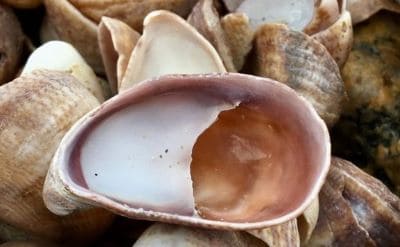Home › Sea Life › Marine › Invertebrates › Mollusks › Snails › Slipper Shell
Interesting Facts about the Slipper Shell
[Phylum: Mollusca] [Class: Gastropoda] [Order: Littorinimorpha] [Family: Calyptraeidae]
Take a walk along the shorelines of the western Atlantic Ocean at low tide and you'll see thousands of oval shaped snails that look like seashells.
This segment contains fun facts and interesting information about slipper shells including their geographical range, feeding habits, and how they reproduce.
Slipper Shells Key Habitats and Distribution
The family of medium-sized shelled gastropods (Crepidula) includes the slipper shell snail species.
Apart from the Eastern coastal regions of North America, they are also found in:
- Nova Scotia
- United Kingdom (known as the slipper limpet)
- The Gulf of Mexico
In fact, slipper shells cause a lot of damage to oyster fisheries in most of Europe. As a result, France, Spain, Denmark, the Netherlands (and others) consider the nonindigenous snail as an invasive species.
For the most part, Crepidula enjoys a cosmopolitan distribution and it tolerates a broad swathe of environmental conditions.
Hence, the populations thrive in sheltered areas protected from strong water movement (e.g. estuaries, shallow bays).
Pro Tip: The main section contains more sea snail facts and information, including the vital role that marine snails have in saltwater seas and oceans around the world.
Slipper Shell Characteristics and Behaviour
The general appearance of the underside of the slipper shell resembles the flattened deck of a boat. But, the top is more rounded and it contains an arched hump, like slippers or thin clogs.
Slipper Shell Species List
 Common slipper shell (Crepidula fornicata)
Common slipper shell (Crepidula fornicata)- Chinese cup-and-saucer (Calyptraea chinensis)
- Convex slippersnail (Crepidula convexa)
- Eastern white slipper limpet (Crepidula walshi)
- Goree slippers shell (Crepidula goreensis)
- Hooked slipper limpet (Crepidula adunca)
- Onyx slippersnail (Crepidula onyx)
- Spiny slippersnail (Bostrycapulus aculeata)
- Spotted slippersnail (Crepidula maculosa)
- Western white slippersnail (Crepidula nummaria)
They spend most of the time in shallow tidal pools. But, records show that some members of the species can exist on rigid substrates at depths of seventy (70) metres (230 feet).
In general, the adults fix themselves to rocks or other solid structures, such as marine pilings. They stack on top of each other in small sedentary groups, sometimes up to sixteen (16) shells high.
Here's the thing:
It's accepted for the bottom shell to be the oldest female. The smaller and younger males will be fastened together and stacked above.
If the female at the base of the pile dies, the largest male changes gender to become a female and takes over the role.
It's not uncommon to find slipper snails growing on top of horseshoe crabs, other large shell species, or inside the empty carcass of a dead mollusk.
Fun Fact: Native to the northwest Atlantic Ocean, Crepidula convexa is one of the smallest slipper shell snails. Its shell rarely grows more than twenty (20) millimetres in size. However, Crepidula fornicata is one of the biggest in the genus with a shell measuring up to 5.6 centimetres.
What Do Slipper Shells Eat?
A layer of sticky mucus covering their large gills helps the vast majority of aquatic snail species trap phytoplankton particles in the water.
Nonetheless, in a similar manner to adult mussels and large clams, they tend to eat most microscopic organisms, including:
- Algae
- Bacteria
- Decaying organic material (detritus)
- Plant particles
Marine prosobranch gastropods (Calyptraeidae) are able to transfer this organic material towards the edge of their gills. They then consume it as food through a process called deposit feeding or suspension.
Crepidula Reproductive Process
In fact, slipper shell breeding can take place anytime from February to October. Even so, the optimum months for spawning are May and June when the water gets warmer. Slipper limpet females tend to spawn twice a year and usually after a neap tide.
Each individual slipper snail is a sequential hermaphrodite. In other words, they all begin as males then transform into females later in life.
After fertilising the eggs "internally", each female disperses thousands of veligers (microscopic swimming larvae). Some of the larvae will escape predators and settle on the ocean floor to metamorphose into adults
Threats and Predators
There are few natural predators of slipper limpet snails, especially in European countries. As a result, they thrive in abundance on shellfish banks and throughout most hard-bottom environments.
Despite the introduction to the Pacific Northwest and Japan, cold water temperature tends to inhibit their natural development and further expansion into the most northerly regions.
Can You Eat Slipper Limpets?
One notable threat to the long term survival of slipper limpets may be the appetite for culinary use (e.g. human consumption). They are a versatile food source with a unique flavour that many countries offer as a main course menu item.
Fun Fact: Limpets are considered a delicacy in the Azores and Hawaii. Reports also suggest that France is trying to harvest and market the slipper shell snail species.